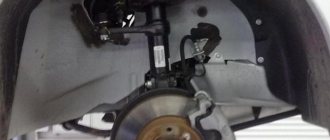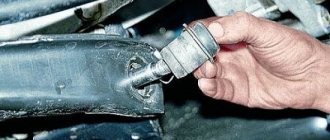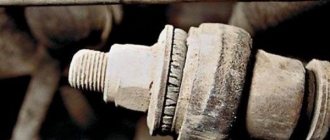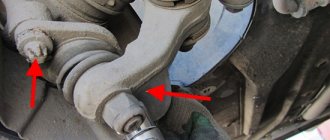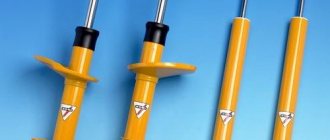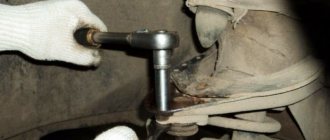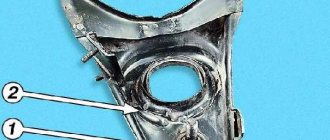Print this article Font size 16
As many car owners know, silent blocks have a direct impact on wheel alignment angles. Therefore, a beginner needs to understand how important it is to monitor the condition of these elements. Replacing the silent blocks of the front levers of a VAZ 2110 is quite simple, but today we will reveal some of the repair features to you.
Suspension design features
A feature of the suspension design is that many of its elements should not be rigidly connected, otherwise it will transfer all the vibration to the body.
How does the VAZ 2110 suspension work?
Therefore, some composite suspensions are connected by means of rubber bushings and rubber pads with metal bushings inside, i.e. silent blocks.
So, in the front independent suspension of the VAZ-2110 the following are connected to each other through silent blocks:
- Lower arm;
- Stretching;
- Anti-roll bar.
Each of these elements plays an important role in the suspension design.
The lower arm prevents lateral movement of the wheel, the extension prevents the wheel from moving longitudinally relative to the body, and the anti-roll bar prevents the body from swaying when performing maneuvers or when driving over uneven surfaces.
But the loads on these elements coming from the wheels are very large, so their displacement, although small, must be provided in order to partially absorb the loads and partially absorb them, and not transfer them to the body.
The possibility of displacement of suspension elements relative to each other and relative to the body, as well as partial damping of vibrations, is provided by silent blocks and rubber bushings.
Front suspension.
On the VAZ-2110, silent blocks and bushings are installed in the front suspension:
- Lower arm (two silent blocks - through one it is attached to the body, and through the second a stretcher is connected to it);
- Stretch bar (one silent block through which it is attached to the crossbar);
- Anti-roll bar (it is connected to the lower arm through a strut with two silent blocks, and to the car body through brackets with rubber bushings).
Rear suspension.
Since the VAZ-2110 has a dependent rear suspension, so many silent blocks are not required, because it is structurally simpler.
At the rear of the entire suspension there are only two silent blocks installed - through which the rear beam is attached to the body brackets.
Beam structure
On the inside, brackets with special holes necessary for installing shock absorbers are attached to the suspension arms. There are also flanges located there, bolted to the axle of the rear wheels and shields located on the brake mechanism. Bushings are attached to the suspension arms on the front side. They are inserted into hinges made of a special rubber-metal material.
Bolts pass through them, connecting the suspension arms together with the stamped-welded brackets. They, in turn, are attached with bolts welded into the side member of the car. The springs of the rear beam of the VAZ 2110 are located in such a way that the first end rests against the recess of the shock absorber, and the second passes through a special gasket directly into the support area attached to the underside of the arch on the car body.
The gasket acts as an insulator and is made of rubber. The shock absorber mounted on the rear suspension is double-acting. It is attached with short bolts directly to a bracket located on the trailing arm in the rear suspension area. In the upper part, fastening is done using the rod method. The rod is fixed in the upper support directly on the suspension spring. The shock absorber is fixed through a protective rubber pad and a support washer.
A double row thrust bearing is located in the middle of the hub. Its structure is very similar to the bearing located in the hub of the front wheels, but it is much smaller in size.
Consequences of consumables malfunction
It should be noted that silent blocks and bushings are consumables.
Due to heavy loads, it is possible that the rubber part of the silent block may be pressed through, detached from the metal bushing, and the rubber itself may delaminate. As a result, they are no longer able to work properly.
This results in knocking from the suspension, the appearance of creaks, when driving, especially over uneven surfaces, the car can throw from side to side, and the more wear on the silent blocks, the stronger the tossing will be.
Also, due to worn silent blocks, the angles of the wheel position - camber and toe - change, because of which the car will no longer hold the road, it will begin to drift in any direction, the tires will quickly wear out due to incorrect angles.
So, the condition of all rubber elements of the car suspension must be constantly monitored, and if signs of malfunction appear, they must be promptly replaced.
With certain knowledge and the availability of tools, you can replace silent blocks yourself without contacting a service center.
It should be noted right away that even if damage to one or two silent blocks is detected, it is better to completely replace all rubber parts of the suspension, and not just the damaged ones.
Also, all elements are replaced immediately on the left and right sides of the car.
In what cases is it necessary to change silent blocks on the top ten?
Typically, experienced drivers quickly determine the reasons for the failure of the elements in question. Firstly, while driving the vehicle, shocks will be felt in the suspension area. Secondly, in the absence of intervention, the silent block structures are destroyed, the angle of the wheels changes and the controllability of the vehicle worsens. If a motorist ignores these problems, then he will face expensive repairs in the future. Let's look at the signs of failure of silent blocks:
- the appearance of tire squeaks while the vehicle is moving. Minor wear produces minimal noise;
- You can hear a knocking noise right next to the wheels. This indicates that the fastening elements of the silent blocks are damaged;
- Upon visual inspection, cracks are visible on the surface of the elements. This is evidence that the parts have lost their operational parameters and require replacement.
Tools and accessories
There are not so many tools that will be required to replace all consumables, but some of them are specific.
So, you will need:
- Set of keys, heads, knobs;
- A set of new oil seals and bushings;
- Device for pressing out and pressing in silent blocks;
- Puller for ball joint;
- Jack;
- Stops;
- Vise;
- Hammer and wooden spacers;
- Soap solution.
Device for pressing out and pressing in silent blocks.
You can buy it or make it yourself.
The simplest homemade device consists of a long bolt with a nut, pieces of pipe with different diameters and several thick washers.
The principle of operation of such a device is very simple.
To press out the silent block, take a bolt and put a washer on it, the size is slightly smaller than the diameter of the rubber part of the silent block.
The bolt is passed through the bushing of the silent block. On the other hand, a piece of pipe with a diameter equal to the diameter of the seat, for example, a lever, is thrown onto the bolt.
That is, the pipe will have to rest against the circumference of the seat in the lever.
Next, another washer is put on the bolt, its circumference larger than the diameter of the pipe, and then the nut is screwed on.
Pressing out is done like this: the nut, when screwed on, will pull towards itself the washer resting on the silent block.
The installed tube will allow it to come out of the seat and not rest against another washer.
Pressing is done in exactly the same way, with the only difference that it is not necessary to use a piece of pipe, since the silent block will rest against the thrust washer when it sits in place.
You can even press-fit without using a device; it is enough to have only a vice, between the jaws of which a new silent block and lever are installed, so that it and its seat are on the same axis.
Next, the vice compresses and the consumable itself falls into place. But in this way you can install silent blocks only on the lever and stabilizer struts, but on the cross member you will still need a device for replacement.
Choosing which ones to buy
It is impossible to say unequivocally which front struts are best to choose for the VAZ 2110. Some choose factory ones because they are not rigid enough for them, others prefer analogues for their softer and more comfortable behavior.
Some people even want to install a sports version of the struts on their “top ten”, since they are the stiffest and the springs are the thickest.
Sports
Focus on what you want to get out of driving. But from the point of view of manufacturers, Samara CC20 devices have proven themselves to be excellent. If necessary, you can figure out how to pump up such racks.
The choice is between oil and gas (gas-oil, actually). The former are more affordable from a financial point of view, but they do not have such a wide temperature range, which is why the shock absorbers become stiffer in winter.
Gas analogues have a more complex design, a high price, but an excellent “tenacity” indicator.
Among the manufacturers, in addition to CC20, the following manufacturing companies can be distinguished:
- KONI
- Sachs
- Kayaba
- Monroe
- Brillstein.
All of them have approximately the same devices, so there should be no problems with selecting suitable parts.
Removing front suspension elements
First, we will describe the sequence of actions to restore the front suspension.
It is better to perform all work in an inspection hole, so you need to place the car on it and immediately loosen the front wheel fastenings.
The front of the car is jacked up on both sides. First, they lift one side, install supports under it, and then lift the second side with a jack and also fix it with supports, after which the wheels are removed.
The first control arm to be removed from the car is the lower control arm. To do this, unscrew the nuts securing the extension, stabilizer strut and ball joint from it.
The lever is removed from the ball joint using a puller.
The last thing to unscrew is the nut securing the lever to the bracket on the body, the bolt is pulled out, and the lever is removed.
Next, the stretch is removed. Since it is already disconnected from the lever, all that remains is to unscrew the nut securing it to the cross member.
The last thing to be removed from the car is the stabilizer.
The stabilizer is attached through the struts to the levers on both sides, so you can either first dismantle it on the other side and start removing the stabilizer, or simply unscrew the nut securing its strut, and dismantle the lever itself and the brace later.
Having disconnected the stabilizer mounts to the arms, to remove it, all that remains is to unscrew the nuts securing the body brackets and remove the stabilizer along with the bushings.
Installation
Recommendation. After replacing the longitudinal extension, it is necessary to check the pitch angle of the steering axis at a service center.
We install the longitudinal extension in the reverse order.
The hole in the adjusting washer is chamfered on one side. When installing adjusting washers, the chamfer should be directed towards the bend of the longitudinal extension.
Today we will talk about how to replace silent blocks on a VAZ 2110.
The suspension is one of the most loaded devices of a car, since it constantly absorbs all the oscillatory movements of the wheel that are transmitted to it from the road surface.
Replacing consumables, eliminating axial play
Having dismantled the suspension elements, you can begin to press out the worn silent blocks and install new ones.
Using a special device prepared in advance, old silent blocks are removed from the crossbar, levers and racks and new ones are pressed into their place.
To facilitate installation, new consumables can be moistened with soapy water.
But the use of petroleum-based lubricants is not recommended, since they have a negative effect on rubber elements.
Regarding the stabilizer struts, before pressing out, they will need to be knocked off the stabilizer, since they are tightly seated on it.
When knocking down, it is better to use a hammer and strike through a wooden spacer.
Also, after removing the struts, the rubber bushings are pulled off the stabilizer and new ones are installed in their place.
Axial play.
Often a phenomenon called axial play occurs at the lower arm.
It is formed when the body bracket to which the lever is attached, for one reason or another, loosened and a gap appeared between it and the metal bushing of the silent block, which is why the silent block itself was able to move along the fastening bolt.
This axial play negatively affects the performance of the suspension, so it should not exist. But if it appears, then there are two ways to eliminate it.
You can try to compress the bracket. But this is very difficult to do, since it is better not to apply impact with a hammer, even through a spacer, and using clamps or a vice is not very convenient.
It is much easier to get rid of axial play using washers that are placed between the bracket and the silent block.
But according to the manual, it is recommended to replace the entire lower control arm with joints
After replacing all consumables, the removed suspension elements are installed in place.
After replacing all the silent blocks on the front suspension, the vehicle must have its wheel alignment angles adjusted.
What you need to prepare for self-repair of silent blocks
Replacing silent blocks or daisies is simply necessary, because this part is responsible for the operation of the car’s suspension. To carry out independent repairs, it is worth preparing a set of spanner wrenches, reliable socket wrenches, a standard vice (if you are used to working with them when pressing out small components), a chisel and a hammer, but this is in case the fasteners have soured and you will have to use force.
Set of tools
You will have a special silent block puller at the beginning of the repair, good, this will certainly make the work easier and speed up the replacement process. You will also have to purchase a new set of silent blocks for replacement in advance and decide how to change the daisies on a VAZ 2114.
Sequence of actions when replacing a VAZ 2110
- The car is installed above the inspection hole, then the lower protective cover of the VAZ 2110 engine compartment is removed.
- The fastening nuts on the front arms are unscrewed, then the nuts of the front stabilizers are unscrewed (this is done using a 17 wrench).
Mounting nut removed
Unscrewing the nut on the extension
Unscrewing the second nut by 24
Removing the old block with a chisel
Stripping the eyelet with a knife
Pressing in the silent block with a vice
Video example of replacing silent blocks of front control arms
Important points
Unscrewing nuts with a 24 mm spanner can be a very difficult task. To move such a nut out of place, as a rule, enormous force is required. And not only that, each next revolution will also require considerable effort. Therefore, it is best to use a long tube mounted on a spanner as a lever.
To make the nuts even easier to unscrew, you can pour plenty of oil on them and wait 10 minutes.
The silent blocks should be pressed in with a hammer blow (or a sledgehammer blow) only after placing the lever on a flat metal surface. In this case, the blow must be very accurate; at the slightest misalignment of the hammer, there is a risk of damage to the silent block.
In order to avoid the above damage, it makes sense to press the silent block into the extension using a vice. A vice will be needed in any case, since new blocks rarely fit completely into the eye after one blow. They almost always need to be “added.”

